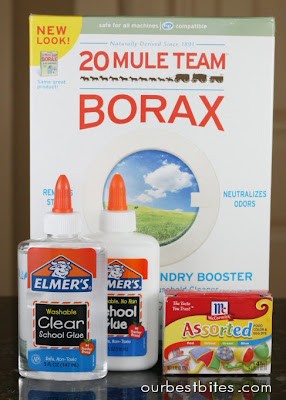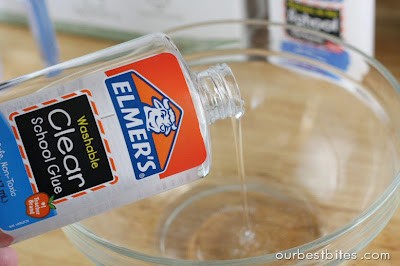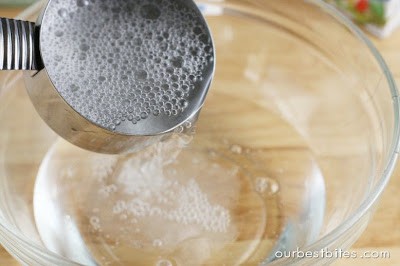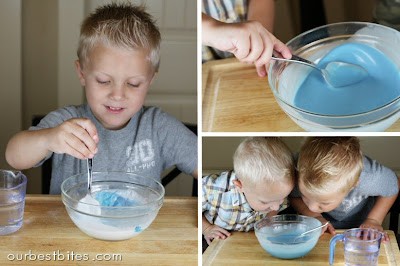Making slime is a fun and engaging activity for people of all ages. This article from HOW.EDU.VN will guide you on the precise amount of borax needed to create the perfect slime, ensuring a safe and enjoyable experience. Whether you’re a parent looking for a creative project for your kids or a DIY enthusiast, understanding the right borax to slime ratio is essential.
1. What is Borax and Why is It Used in Slime Making?
Borax, also known as sodium borate, sodium tetraborate, or disodium tetraborate, is a naturally occurring mineral compound. It’s a salt of boric acid and has been used for various purposes, including cleaning, laundry, and yes, even slime making.
- Chemical Composition: Na2B4O7·10H2O
- Appearance: White, crystalline powder
- Solubility: Soluble in water
1.1. The Science Behind Borax in Slime
When making slime, borax acts as an activator. It cross-links the polymer chains in polyvinyl alcohol (PVA), which is found in many types of glue. This cross-linking process causes the glue to thicken and become the stretchy, gooey substance we know as slime.
1.2. Why is Borax an Essential Ingredient?
Borax is essential because it provides the necessary ions to create the slime’s structure. Without it, the glue would remain a liquid, failing to achieve the desired texture and consistency.
1.3. Safety Precautions When Using Borax
While borax is a common household product, it’s crucial to handle it with care:
- Avoid Ingestion: Borax should not be ingested. Keep it away from young children who might put it in their mouths.
- Skin Contact: Prolonged skin contact can cause irritation. It’s best to wear gloves or wash your hands thoroughly after handling borax.
- Eye Contact: Borax can irritate the eyes. If it comes into contact with your eyes, rinse immediately with plenty of water.
- Ventilation: Use borax in a well-ventilated area to avoid inhaling any dust.
1.4. Alternatives to Borax
If you’re concerned about using borax, several alternatives can achieve similar results. These include:
- Liquid Laundry Starch: Contains similar cross-linking agents.
- Contact Lens Solution: Must contain boric acid and sodium borate.
- Baking Soda and Saline Solution: A milder alternative, often used for sensitive skin.
2. How Much Borax for Slime: The Perfect Ratio
The key to making perfect slime lies in using the correct amount of borax. Too little, and your slime will be too sticky; too much, and it will be hard and rubbery.
2.1. The Standard Borax Solution
The most common and effective method is to create a borax solution. Here’s how:
- Measure: Use 1 teaspoon of borax powder.
- Dissolve: Mix the borax powder with 1 cup (8 ounces) of warm water.
- Stir: Stir the mixture until the borax is completely dissolved.
This solution will be your activator for the slime.
2.2. Borax to Glue Ratio
The ratio of borax solution to glue is crucial. A good starting point is:
- 4 ounces (1/2 cup) of glue: Use approximately 1-2 tablespoons of borax solution.
You can adjust this ratio slightly based on the type of glue and desired consistency.
2.3. Step-by-Step Guide to Making Slime with Borax
Here’s a detailed guide to making slime using borax:
- Prepare the Borax Solution: As described above, dissolve 1 teaspoon of borax in 1 cup of warm water.
- Prepare the Glue Mixture: In a separate bowl, pour 4 ounces (1/2 cup) of glue. You can use clear or white school glue.
- Add Water (Optional): For a stretchier slime, add 1/4 cup of water to the glue and mix well.
- Add Color (Optional): Add a few drops of food coloring to the glue mixture and stir until you achieve the desired color.
- Slowly Add Borax Solution: Gradually add the borax solution to the glue mixture, one tablespoon at a time. Stir continuously.
- Mix Until Slime Forms: As you add the borax solution, the mixture will start to clump and form slime. Keep stirring until most of the liquid is absorbed.
- Knead the Slime: Once the slime has formed, remove it from the bowl and knead it with your hands. It will be sticky at first, but as you knead, it will become smoother and less sticky.
- Adjust Consistency: If the slime is too sticky, add a little more borax solution. If it’s too hard, add a little water or glue.
- Store Properly: Store the slime in an airtight container to prevent it from drying out.
2.4. Troubleshooting Common Slime Issues
- Slime is Too Sticky: Add a small amount of borax solution, knead well, and repeat until the desired consistency is reached.
- Slime is Too Hard: Add a small amount of water or glue, knead well, and repeat until the slime becomes softer.
- Slime is Not Forming: Make sure your borax solution is properly mixed and that you are adding enough of it to the glue.
- Slime is Clumpy: This can happen if you add the borax solution too quickly. Try adding it more slowly and mixing continuously.
2.5. Different Types of Glue and Their Borax Requirements
The type of glue you use can affect the amount of borax solution needed.
| Glue Type | Borax Solution Needed | Notes |
|---|---|---|
| White School Glue | 1-2 tablespoons per 4 oz glue | A standard choice, works well with the recommended borax ratio. |
| Clear School Glue | 1.5-2.5 tablespoons per 4 oz glue | May require slightly more borax solution to achieve the right consistency. |
| Glitter Glue | 2-3 tablespoons per 4 oz glue | The added glitter can affect the consistency, requiring more borax solution. |




3. Advanced Slime Recipes and Borax Usage
Once you’ve mastered the basic slime recipe, you can explore more advanced variations.
3.1. Fluffy Slime
Fluffy slime is light and airy, thanks to the addition of shaving cream.
-
Ingredients:
- 4 ounces (1/2 cup) of white school glue
- 1/4 cup of water
- 2-3 cups of shaving cream
- 1-2 tablespoons of borax solution
-
Instructions:
- Mix the glue and water in a bowl.
- Add the shaving cream and stir until well combined.
- Gradually add the borax solution, stirring until the slime forms.
- Knead the slime until it is smooth and fluffy.
3.2. Clear Slime
Clear slime is transparent and glossy, making it perfect for adding glitter or other decorations.
-
Ingredients:
- 4 ounces (1/2 cup) of clear school glue
- 1/4 cup of water
- 1.5-2.5 tablespoons of borax solution
-
Instructions:
- Mix the glue and water in a bowl.
- Gradually add the borax solution, stirring until the slime forms.
- Knead the slime until it is clear and smooth.
3.3. Butter Slime
Butter slime is soft and spreadable, resembling butter. It gets its unique texture from the addition of clay.
-
Ingredients:
- 4 ounces (1/2 cup) of white school glue
- 1/4 cup of water
- 1-2 tablespoons of borax solution
- 1/4 cup of মডেলিং clay (such as Daiso soft clay)
-
Instructions:
- Mix the glue and water in a bowl.
- Gradually add the borax solution, stirring until the slime forms.
- Knead the slime until it is smooth.
- Add the clay and knead until it is fully incorporated and the slime is soft and spreadable.
3.4. Cloud Slime
Cloud slime has a unique, snowy texture due to the addition of instant snow powder.
-
Ingredients:
- 4 ounces (1/2 cup) of white school glue
- 1/4 cup of water
- 1-2 tablespoons of borax solution
- 2-3 tablespoons of instant snow powder
-
Instructions:
- Mix the glue and water in a bowl.
- Gradually add the borax solution, stirring until the slime forms.
- Knead the slime until it is smooth.
- Add the instant snow powder and knead until it is fully incorporated and the slime has a cloud-like texture.
3.5. How Borax Amounts Differ in Advanced Recipes
In advanced slime recipes, the amount of borax needed may vary depending on the additional ingredients. For example, shaving cream in fluffy slime can dilute the glue, requiring slightly more borax solution to achieve the desired consistency. Similarly, clay in butter slime can affect the slime’s texture, so you may need to adjust the borax amount accordingly.
4. Safety Tips for Making Slime with Borax
Ensuring safety while making slime is paramount, especially when children are involved.
4.1. Adult Supervision
Always supervise children when making slime with borax. Young children may not understand the importance of not ingesting the ingredients or the need to wash their hands after handling the slime.
4.2. Proper Handling of Borax
Borax is a chemical compound and should be handled with care:
- Storage: Store borax in a secure container, out of reach of children and pets.
- Mixing: Always mix borax in a well-ventilated area to avoid inhaling dust.
- Contact: Avoid prolonged skin contact with borax. Wear gloves if necessary.
- Disposal: Dispose of borax solution properly, following local regulations.
4.3. What to Do in Case of Accidental Ingestion or Contact
- Ingestion: If borax is accidentally ingested, call a poison control center or seek medical attention immediately.
- Eye Contact: If borax comes into contact with the eyes, rinse immediately with plenty of water for at least 15 minutes.
- Skin Contact: If borax causes skin irritation, wash the affected area with soap and water. If irritation persists, seek medical attention.
4.4. Recognizing Signs of Borax Sensitivity or Allergy
Some people may be sensitive or allergic to borax. Signs of a reaction may include:
- Skin Rash: Red, itchy rash on the skin.
- Eye Irritation: Redness, itching, or watering of the eyes.
- Respiratory Issues: Coughing, wheezing, or difficulty breathing.
If you experience any of these symptoms, discontinue use of borax and seek medical attention.
4.5. Safe Disposal of Slime
Dispose of slime properly to avoid environmental contamination. Do not flush slime down the toilet, as it can clog pipes. Instead, dispose of it in a sealed bag in the trash.
5. Understanding the Science Behind Slime and Borax
Delving into the scientific principles behind slime making can enhance the experience and provide educational value.
5.1. Polymers and Cross-Linking
Slime is a non-Newtonian fluid, meaning it doesn’t follow Newton’s law of viscosity. It behaves like a solid under stress and a liquid when relaxed. This unique property is due to the polymers in glue.
- Polymers: Long chains of repeating molecular units. In glue, the main polymer is polyvinyl alcohol (PVA).
- Cross-Linking: The process of linking polymer chains together. Borax acts as a cross-linking agent, creating bonds between the PVA chains.
5.2. How Borax Interacts with Glue on a Molecular Level
When borax is added to glue, the borate ions (from sodium borate) react with the PVA chains. These borate ions form bridges between the PVA chains, creating a network structure. This network structure is what gives slime its elasticity and gooey texture.
5.3. The Role of pH in Slime Formation
The pH level of the mixture can affect slime formation. Borax is alkaline, and it works best in a slightly alkaline environment. Adding acidic substances can interfere with the cross-linking process and prevent slime from forming properly.
5.4. Temperature Effects on Slime Consistency
Temperature can also affect slime consistency. Warm temperatures can make slime more liquid, while cold temperatures can make it more solid. This is because temperature affects the movement of the polymer chains and the strength of the cross-links.
5.5. Experiments to Demonstrate Slime’s Properties
- Viscosity Test: Observe how slime flows when poured slowly versus quickly.
- Elasticity Test: Stretch slime to see how far it can be stretched before breaking.
- Stress Test: Poke or squeeze slime to see how it behaves under stress.
- Temperature Test: Place slime in the refrigerator and observe how its consistency changes over time.
6. Common Mistakes to Avoid When Making Slime
Avoiding common mistakes can ensure a successful slime-making experience.
6.1. Using Too Much or Too Little Borax
- Too Much Borax: Results in a hard, rubbery slime that is not stretchy.
- Too Little Borax: Results in a sticky, liquid slime that does not hold its shape.
Always measure borax carefully and add it gradually, adjusting as needed.
6.2. Not Dissolving Borax Properly
If borax is not fully dissolved in water, it can cause clumps in the slime. Make sure to stir the borax solution until it is completely clear.
6.3. Adding Borax Solution Too Quickly
Adding the borax solution too quickly can cause the slime to become clumpy and uneven. Add it slowly, one tablespoon at a time, stirring continuously.
6.4. Using Expired or Low-Quality Glue
Expired or low-quality glue may not contain the necessary polymers for slime formation. Use fresh, high-quality glue for best results.
6.5. Neglecting to Knead the Slime
Kneading the slime is essential for achieving the right consistency. Kneading helps to distribute the borax solution evenly and create a smooth, stretchy texture.
7. Borax-Free Slime Alternatives
For those who prefer to avoid borax, several alternatives can be used to make slime.
7.1. Slime with Liquid Laundry Starch
Liquid laundry starch contains similar cross-linking agents to borax and can be used to make slime.
-
Ingredients:
- 4 ounces (1/2 cup) of glue
- 1/4 cup of water
- 1/4 cup of liquid laundry starch
-
Instructions:
- Mix the glue and water in a bowl.
- Gradually add the liquid laundry starch, stirring until the slime forms.
- Knead the slime until it is smooth and stretchy.
7.2. Slime with Contact Lens Solution
Contact lens solution containing boric acid and sodium borate can also be used to make slime.
-
Ingredients:
- 4 ounces (1/2 cup) of glue
- 1/4 cup of water
- 1/2 tablespoon of baking soda
- 1-2 tablespoons of contact lens solution
-
Instructions:
- Mix the glue and water in a bowl.
- Add the baking soda and stir well.
- Gradually add the contact lens solution, stirring until the slime forms.
- Knead the slime until it is smooth and stretchy.
7.3. Slime with Baking Soda and Saline Solution
This is a milder alternative, often used for sensitive skin.
-
Ingredients:
- 4 ounces (1/2 cup) of glue
- 1/4 cup of water
- 1 tablespoon of baking soda
- 2-3 tablespoons of saline solution
-
Instructions:
- Mix the glue and water in a bowl.
- Add the baking soda and stir well.
- Gradually add the saline solution, stirring until the slime forms.
- Knead the slime until it is smooth and stretchy.
7.4. Comparing the Texture and Consistency of Borax-Free Slimes
Borax-free slimes may have a slightly different texture and consistency compared to borax slime. Liquid laundry starch slime tends to be more rubbery, while contact lens solution slime is often smoother and stretchier. Baking soda and saline solution slime is generally milder and less firm.
7.5. The Pros and Cons of Borax-Free Slime
| Slime Type | Pros | Cons |
|---|---|---|
| Borax Slime | Stretchy, firm, easy to make | Contains borax, may cause irritation |
| Liquid Laundry Starch | Easy to find ingredients, good texture | Can be rubbery, may contain harsh chemicals |
| Contact Lens Solution | Smooth, stretchy, milder | Requires specific contact lens solution, can be more expensive |
| Baking Soda & Saline | Milder, safer for sensitive skin | Less firm, can be stickier |
8. Adding Fun Extras to Your Slime
Enhance your slime-making experience by adding fun extras.
8.1. Food Coloring
Food coloring is a simple way to add vibrant colors to your slime. Add a few drops to the glue mixture and stir until you achieve the desired color.
8.2. Glitter
Glitter adds sparkle and shine to your slime. Add glitter to the glue mixture and stir until it is evenly distributed.
8.3. Essential Oils
Essential oils can add pleasant scents to your slime. Add a few drops to the glue mixture and stir until the scent is evenly distributed.
8.4. Beads and Sequins
Beads and sequins add texture and visual interest to your slime. Add them to the finished slime and knead until they are fully incorporated.
8.5. Foam Beads
Foam beads create a unique, crunchy texture in your slime. Add them to the finished slime and knead until they are fully incorporated.
9. Storing and Maintaining Your Slime
Proper storage and maintenance can prolong the life of your slime.
9.1. Best Types of Containers for Slime
Store slime in airtight containers to prevent it from drying out. Ziplock bags, plastic containers with lids, and glass jars are all good options.
9.2. How to Prevent Slime from Drying Out
- Airtight Storage: Always store slime in an airtight container when not in use.
- Adding Water: If slime starts to dry out, add a small amount of water and knead until it is rehydrated.
- Avoiding Air Exposure: Minimize air exposure by keeping the container sealed as much as possible.
9.3. How to Revive Hard or Stiff Slime
If slime becomes hard or stiff, try the following:
- Warm Water: Soak the slime in warm water for a few minutes, then knead until it is soft.
- Lotion: Add a small amount of lotion and knead until it is fully incorporated.
- Glue: Add a small amount of glue and knead until the slime is stretchy.
9.4. Cleaning Up Slime Spills
Slime spills can be messy, but they are usually easy to clean up:
- Remove Excess: Scrape off as much slime as possible with a spatula or spoon.
- Soak with Vinegar: Soak the affected area with white vinegar to dissolve the slime.
- Wipe Clean: Wipe the area clean with a damp cloth.
- Wash Fabric: If the spill is on fabric, wash the item in the washing machine.
9.5. How Long Does Slime Last?
With proper storage and maintenance, slime can last for several weeks or even months. However, it may eventually become contaminated with bacteria or mold, so it’s best to discard it if it starts to smell bad or change color.
10. The Benefits of Making Slime
Making slime is not only fun but also offers several educational and developmental benefits.
10.1. Sensory Play and Development
Slime provides a rich sensory experience that can help children develop their tactile skills. The squishy, stretchy texture of slime can be calming and soothing, making it a great tool for sensory play.
10.2. Creativity and Experimentation
Making slime encourages creativity and experimentation. Children can explore different colors, textures, and additives, allowing them to express their unique ideas and develop their problem-solving skills.
10.3. Science Education
Slime making can be a fun way to introduce children to basic scientific concepts such as polymers, cross-linking, and chemical reactions. They can learn about these concepts through hands-on experimentation and observation.
10.4. Fine Motor Skills
Kneading, stretching, and manipulating slime can help children develop their fine motor skills and hand-eye coordination. These skills are important for writing, drawing, and other everyday tasks.
10.5. Stress Relief
Playing with slime can be a great way to relieve stress and anxiety. The repetitive motions of squishing and stretching slime can be calming and therapeutic for both children and adults.
11. Consulting Experts at HOW.EDU.VN for Complex Slime-Making Issues
While making slime is generally straightforward, complex issues can arise. HOW.EDU.VN offers expert consultations to address any challenges you may encounter.
11.1. When to Seek Expert Advice
Consider seeking expert advice if you experience persistent issues such as:
- Inconsistent Results: Difficulty achieving the desired slime consistency despite following recipes carefully.
- Ingredient Compatibility: Uncertainty about how different ingredients will interact.
- Safety Concerns: Doubts about the safety of certain ingredients or procedures.
- Scaling Recipes: Problems adjusting recipes for larger or smaller batches.
11.2. How HOW.EDU.VN Can Help
HOW.EDU.VN provides access to experienced professionals who can offer personalized guidance and solutions. Our experts can:
- Troubleshoot Problems: Identify the root causes of your slime-making issues.
- Provide Custom Recipes: Develop tailored recipes to meet your specific needs and preferences.
- Offer Safety Advice: Ensure you are using safe ingredients and following safe procedures.
- Optimize Techniques: Help you refine your techniques for consistent, high-quality results.
11.3. Benefits of Consulting Our PhDs
Consulting with our team of over 100 PhDs offers several unique advantages:
- Expert Knowledge: Access in-depth knowledge and expertise in chemistry, materials science, and related fields.
- Personalized Solutions: Receive customized advice tailored to your specific challenges.
- Confidence and Assurance: Gain peace of mind knowing you are following best practices and using safe ingredients.
11.4. How to Get in Touch with Our Experts
Contacting our experts is easy. Simply visit our website HOW.EDU.VN and follow these steps:
- Sign Up: Create an account on HOW.EDU.VN.
- Describe Your Issue: Provide a detailed description of the slime-making challenges you are facing.
- Submit Your Query: Submit your query to our team of experts.
- Receive Personalized Advice: Receive tailored advice and solutions from our PhDs.
11.5. Success Stories from Our Clients
Many of our clients have benefited from our expert consultations. For example, a teacher struggling with inconsistent slime results for her classroom activities was able to develop a reliable recipe and procedure after consulting with one of our PhDs. A parent concerned about the safety of borax was able to find a safe and effective borax-free alternative with our guidance.
12. Testimonials and Success Stories
Real-life examples highlight the benefits of using the correct borax ratio and seeking expert advice.
12.1. Case Study 1: The Perfect Classroom Slime
A science teacher, Mrs. Johnson, wanted to incorporate slime-making into her curriculum but struggled with inconsistent results. After consulting with experts at HOW.EDU.VN, she learned the precise borax-to-glue ratio and the importance of proper mixing. Now, her students consistently create perfect slime, making learning fun and engaging.
12.2. Case Study 2: Safe Slime for Sensitive Skin
A parent, Mr. Smith, was concerned about using borax due to his child’s sensitive skin. Through HOW.EDU.VN, he discovered a borax-free alternative using contact lens solution and baking soda. His child now enjoys making slime without any skin irritation.
12.3. Testimonial 1: From a DIY Enthusiast
“I always struggled with making slime until I found HOW.EDU.VN. The detailed guide on borax ratios and the troubleshooting tips were invaluable. Now, I can make perfect slime every time ” – Emily R.
12.4. Testimonial 2: From a Parent
“As a parent, safety is my top priority. HOW.EDU.VN provided me with safe alternatives to borax and clear instructions on how to make slime with my kids. We now have hours of fun without any worries ” – Michael T.
12.5. The Impact of Expert Guidance on Slime Quality
Expert guidance ensures consistent, high-quality slime. By understanding the science behind slime making and following precise instructions, you can avoid common mistakes and create slime that is safe, fun, and long-lasting.
13. Frequently Asked Questions (FAQs) About Borax and Slime
Addressing common questions can help clarify any remaining doubts.
13.1. Is Borax Safe for Children to Use in Slime?
Borax is generally safe for children to use in slime under adult supervision. It is essential to follow safety precautions, such as avoiding ingestion and washing hands after handling.
13.2. What Happens if You Use Too Much Borax in Slime?
Using too much borax can result in a hard, rubbery slime that is not stretchy. It is best to add borax gradually and adjust as needed.
13.3. Can I Use Borax Substitutes for Making Slime?
Yes, several borax substitutes can be used for making slime, including liquid laundry starch, contact lens solution, and baking soda with saline solution.
13.4. How Do I Store Slime to Keep It from Drying Out?
Store slime in an airtight container, such as a Ziplock bag or plastic container with a lid, to prevent it from drying out.
13.5. What Should I Do If My Slime Gets Moldy?
If your slime gets moldy, discard it immediately. Do not try to revive it, as mold can be harmful.
13.6. Can I Add Essential Oils to Slime?
Yes, you can add essential oils to slime for fragrance. However, use them sparingly, as some essential oils can irritate the skin.
13.7. How Can I Make My Slime More Stretchy?
To make your slime more stretchy, add a small amount of water or lotion and knead until it is fully incorporated.
13.8. What is the Best Type of Glue to Use for Slime?
The best types of glue to use for slime are white school glue and clear school glue.
13.9. How Much Does it Cost to Consult a PhD at HOW.EDU.VN for Slime-Making Issues?
The cost of consulting a PhD at HOW.EDU.VN varies depending on the complexity of the issue and the length of the consultation. Please visit our website for pricing details.
13.10. Are There Any New Innovations in Slime-Making Techniques?
Yes, slime-making techniques are constantly evolving. Recent innovations include the use of new additives such as clay, foam beads, and instant snow powder to create unique textures and effects.
14. Conclusion: Mastering Slime with the Right Borax Ratio
Mastering slime making involves understanding the correct borax ratio and following safety precautions. With the right knowledge and techniques, you can create perfect slime every time. For complex issues and personalized guidance, consult the experts at HOW.EDU.VN to ensure a safe and successful slime-making experience.
Ready to take your slime-making skills to the next level? Contact HOW.EDU.VN today and let our team of over 100 PhDs provide you with the expert guidance you need. Whether you’re struggling with inconsistent results, ingredient compatibility, or safety concerns, our experts are here to help. Don’t let slime-making challenges hold you back – reach out to HOW.EDU.VN and unlock your slime-making potential.
Contact Us:
- Address: 456 Expertise Plaza, Consult City, CA 90210, United States
- WhatsApp: +1 (310) 555-1212
- Website: how.edu.vn

